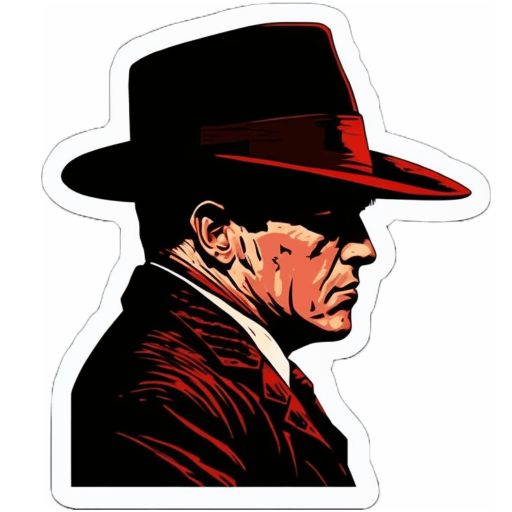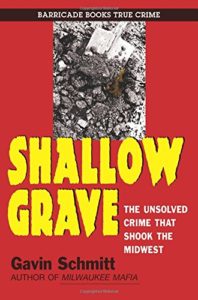Tony Biernat – 1963 Murder
Kenosha, Wisconsin businessman Tony Biernat was murdered on January 7, 1963. His body was found in a shallow grave in the basement of a vacant farmhouse on the abandoned Bong Air Force Base on January 28, 1963. Many speculate that his murder was related to his jukebox business because he had customers in both the Chicago Outfit’s and Milwaukee Mafia’s territories at the time of his death.
As of 2022, nearly 60 years later, no one has been convicted of Tony’s murder. One thing to note is that if Biernat’s murder was connected to the mafia, it would be inherently difficult to solve because those who physically kill someone are not the same person (or people) who had direct problems with the victim or “ordered the hit”.
My Book: Shallow Grave
For in-depth information surrounding the investigation into Tony Biernat’s murder, check out my book, Shallow Grave. (affiliate link)
Shallow Grave is based on previously unreleased law enforcement records from the Kenosha County Sheriff’s Department, the Kenosha County Medical Examiner’s Office, and the FBI.
Anthony J. Biernat (1916-1963)
Anthony Joseph Biernat was born on April 4, 1916 in Chicago to Polish immigrants, Joseph and Mary (Majta) Biernat. He moved to Kenosha in 1937, and married Irene Satko in 1942. They lived in Kenosha, and had two children.
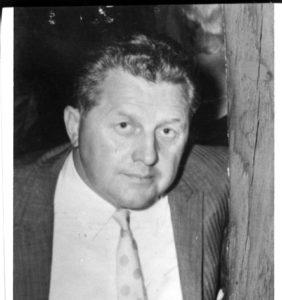
Photo of Tony Biernat
Tony’s obituary states that he was a member of St. Thomas Aquinas Church, the Eagles club, the Elks club, the yacht club, and the Power Squadron. Additionally, he was a 25-year member of the Music Operators of America, and a member of the Wisconsin Music Operators Association.
January 7, 1963 Timeline
–12:30 pm: Tony left from his office for lunch with his employee, Sam Iaquinta, and best friend, Willie Korbel. They ate at Krok’s.
–1:30 pm: On the way out of Krok’s Tony stopped briefly to talk with his friend, Vi Christiansen. They left, and Sam dropped Tony back off at his business.
–4:45 pm: Tony stopped at the Gosselin Electric Company to pay his utility bill.
–6:00 pm: At his home, Tony ate supper with his wife and two children.
– Around 7:00 pm: Tony left his home in his wife’s Invicta, and stopped at the DX service station.
– Around 8:50 pm: Tony returned to his office. (It was common practice to be at the office late in case a service call from a tavern came in.) Chris Juliani, Joseph Yukus, Artie Faraca, and Willie Korbel were also there.
– 9:20 pm: Tony and Willie Korbel walked over to the Keno Koffee Pot where Tony had tea and a pineapple sundae.
– Tony popped back into his office to say goodnight. Tony drove off, and Yukus shut down the office.
– Tony stopped at the North Shore Depot to pick up a newspaper, as he did almost nightly. Willie Korbel was also there picking up a newspaper. Korbel left.
As Tony was walking back to his car, he was sucker punched and knocked on the trunk of his vehicle. He called out for help, and was beaten again and again until he went limp. Three men dragged him from the sidewalk into the back of a waiting car with a fourth man in the driver’s seat. There were several witnesses present throughout the ordeal. Several people saw three men in the car, and Tony in the back with his arms draped over the front passenger’s seat. The car sped off into the night. None off the witnesses called the police.
The Next Morning
On January 8, 1963, an early morning commuter found a bloody overcoat at the North Shore Depot, and alerted the police. Police arrived, and found car keys, and Tony’s car parked nearby with blood smears on the trunk. They called Tony’s niece, Barbara, who worked at the Kenosha National Bank. [It is unclear why they called Barbara, and not Tony’s wife, Irene.] Barbara called Irene around 9:00 am, and told her that the police found Tony’s keys at the North Shore Depot. Irene rushed over to the Depot.
Investigation
Two simultaneous investigations began: one by the Kenosha County Sheriff’s Department, lead by William Schmitt [no relation to Gavin Schmitt], and the other by the Kenosha FBI, headed up by William Higgins. They each looked into two different aspects of the crime, and thus had two very different, yet parallel investigations. The Sheriff’s Department looked at it like a missing person’s case with a potential murder. The FBI was focusing on the kidnapping aspect as they thought it was possible that the abduction was linked to the Sicilian Mafia in Milwaukee and Kenosha.
The investigation focused on three key suspects: William “Weezer” Covelli, Steve DiSalvo, and Joseph Gurera. It was alleged that they stopped by Tony’s business in November 1962, threatened Tony, and threated to take over his business. (Extortion was a common mafia practice.)
William Covelli
William Covelli, nicknamed “Weezer”, was a Kenosha native who had been arrested multiple times for crimes such as operating a gambling parlor, running a still, and a series of burglaries. He was the son of William “Red” Covelli, who was widely believed to be the boss of the West Side Gang in Kenosha in the 1930s and 1940s. Red had been implicated in illegal activities, including murder, but was able to avoid prosecution. On June 10, 1945, Red was shot with several 12-gauge shotgun blasts as he entered his car in front of his home. One of the shots hit him in the head, killing him instantly. His partner, Frank Cosentino, was shot dead in 1941.
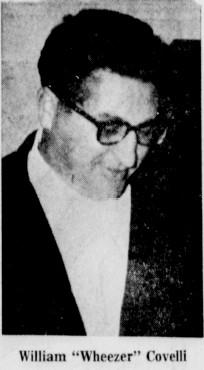
Around 1960/1961, Weezer’s gambling activities were allegedly part of the Milwaukee Mafia where Frank Balistrieri was said to take 10% of the profits. It is unclear why Weezer switched his allegiance from the West Side Gang to the Milwaukee Mafia. And some speculate that Weezer was somewhat of an ambassador between the two groups.
When interviewed about Tony’s murder, Covelli said that he was a business associate of Tony’s, and he denied ever having any disagreements with Tony. Weezer claimed that on multiple occasions, when he installed one of his cigarette machines in a business, he would recommend Tony to the business owner if they also wanted a jukebox.
Weezer confirmed that he had stopped by Tony’s business with Joseph Gurera and Steve DiSalvo in November 1962, but denied that they were there to threaten him. Weezer told police that Gurera and DiSalvo were his gambling buddies who would join him at the racetrack or play some cards. Covelli said that the reason for his November 1962 visit was to let Tony know that he was thinking about expanding into jukeboxes, and it was a “courtesy call” to give Tony a heads-up in case he saw a Covelli-owned jukebox somewhere. He added that the expansion was only hypothetical as he currently had two jukeboxes, and they were in businesses owned by Covelli’s family.
Joseph Gurera
Joseph Gurera, nicknamed “Joey G.”, was born and raised in Kansas City, Missouri, and was a soldier under the direct authority of mob boss Nick Civella. Gurera and his maternal uncles, John “Johnny Mag” and Tony Mangiaracina, worked together as bookies during each baseball season. John was considered one of the top ten mobsters in Kansas City, and he and Gurera co-owned a pool hall, Mag’s Recreation Parlor, for many years.
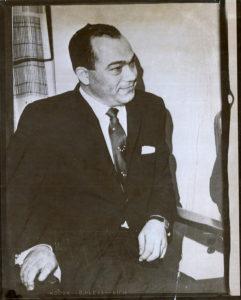
Gurera had been suspected in multiple burglaries, an arson, a few murders, and extortion. When the authorities brought him in for questioning, it was not uncommon to find him with a double-barreled shotgun, and riding with a fellow mobster, Charles Cerrito.
Around 1960, Gurera owned a laundromat in Leavenworth, Kansas, just five blocks from the federal prison. He became the mob’s go-to guy for imprisoned mobsters’ visiting relatives who wanted an escort when going to the prison.
At the request of Frank Balistrieri, Gurera was temporarily transferred from the mafia in Kansas City to the Milwaukee Mafia. He was joined by his brother-in-law, Buster Balestrere, for the purpose of putting pressure on Milwaukee-area bookies who weren’t paying enough “street tax” on their earnings to Balistrieri in order to operate.
Steve DiSalvo
Steve DiSalvo was in the Milwaukee Mafia, and was considered Frank Balistrieri’s right-hand man. He would act as the middleman between Balistrieri and Balistrieri’s “interests”. DiSalvo was often in the company of members and associates of the Milwaukee Mafia.
In March 1962, DiSalvo, Buster Balestrere, and Gurera met with “higher-ups” from other organizations to get the okay to organize and shake down the independent bookies in Milwaukee, as it was possible that a local Milwaukee bookie was backed by another criminal organization.
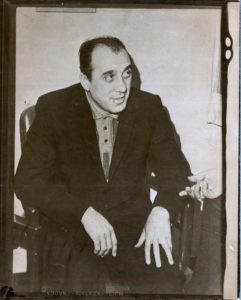
In December 1962, Attorney Dominic Frinzi and Steve DiSalvo picked up Frank Stelloh from Waupun State Prison. Stelloh was an associate of the Milwaukee Mafia, and considered to be “muscle”. A party was thrown for him at Gurera’s house.
In January 1963, police interviewed Gurera and DiSalvo about Tony Biernat. Their attorney, Dominic Frinzi, was present. They denied knowing Tony, seeing Tony, and claimed they wee not able to recognize him from a photo. Regarding the alleged November 1962 meeting at Tony’s business, they denied being in Kenosha in November 1962, knowing where Lakeside Music is located, approaching Tony about his jukebox business, and knowing William Covelli. They were asked where they were on the night of January 7, 1963 (date of Tony’s abduction). Gurera said that he was at home, and DiSalvo said that he was at home all night other than when he went to get a newspaper.
Additionally, the police asked what they did for a living, and they said they were partners in a cleaning business in Milwaukee. They would not give the name of the business, and the reasoning is that they claimed the publicity from the newspapers has been ruinous for them, so much so that they had to change the name of the business. Three of the names the business had used were Acino Cleaners, Unity Cleaners and Checker Cleaners.
The following month, in February 1963, the tax authorities temporarily shut down DiSalvo and Gurera’s cleaning business for failure to pay years of back taxes. They weren’t allowed to reopen until the back taxes were paid.
Tony Biernat’s Body Found
On January 24, 1963, the FBI received a tip from an undisclosed informant about the location of Tony Biernat’s body. The informant hinted that Tony’s body was outside of the city within the county, in a shallow grave in the basement of an abandoned building and partially covered by dirt. Additionally, they were told that lime and cement were used in the hiding of the body, and most likely the empty bags would be found nearby.
On January 28, 1963 at 6:10 pm, Tony Biernat’s body was found in a makeshift grave in the basement of a farmhouse on the inactive Bong Air Force Base, a largely unpopulated area in western Kenosha County more than twenty miles from the North Shore Depot. Tony’s body was found in the building known as the Rutledge house.
Officer Robert Cantwell was the first to descend the icy basement steps, where he saw a bloody palm print and numerous blood-stained magazines. In the basement, there was a mound of dirt with a green canvas tarp partially buried within. The officers unearthed Tony’s body. It was covered in lime, and his wrists were bound together by wire. When measured, the makeshift grave came to 26 inches wide, 52 inches long and 36 inches deep.
For in-depth information surrounding the investigation into Tony Biernat’s murder, check out my book, Shallow Grave. (affiliate link)
Aftermath
No one has been held accountable for Tony Biernat’s 1963 murder, and the three men that the police honed in on are now deceased.
Joseph Gurera died on December 30, 1967 at 42 years old from a heart attack.
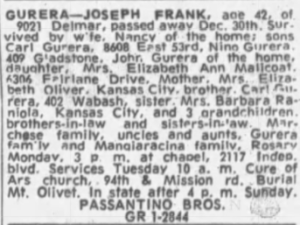
Steve DiSalvo died of brain cancer at age 73 at a Las Vegas hospice on June 9, 1990. He had just been released form federal prison the prior month.
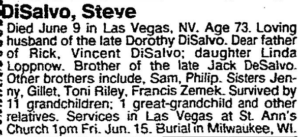
After 1963, William “Weezer” Covelli kept a low profile. He died at the age of 86 in 2006.

